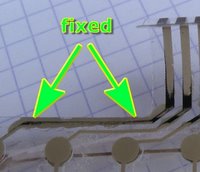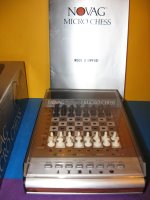Symptoms
The sensor board (later called keyboard in this page) was not responding! Not even one row! All the other push buttons were doing their job well (the NEW GAME, LEVEL, SOUND and so on were correct).
Probable cause
After opening the case, and after disconnecting the keyboard from the printed circuit board, I tried to emulate a contact with a 220 ohms resistor placed between the microprocessor pins corresponding to one row and one column lines. 220 ohms was all I had during my summer holidays (in the country, no bakery, no grocery, you cannot imagine), and it is close to the nominal ON resistance of such keyboard: Between 50 and 200 ohms, I think. The NOVAG MICRO CHESS worked!
So the probable cause was no flow of current through the two conductive strips on the layers of the keyboard.
Note: The keyboard is made of three layers, maybe of Mylar or of plastic. The upper and lower layers have conductive strips and big conductive dots for the contacts. The center layer has holes around the dots, and is probably used to isolate the upper and lower layers. It looks like what I called, in France and in the past century, a Mecanorma keyboard (clavier Mecanorma). It is sometimes known as membrane board sensor.
More investigations
I had noticed that some conducting strips were silver gray (their normal color) while some others were black. So, with a digital multimeter, I checked if the current could flow through the gray (conducting) strip. The verdict was clear:
- When the strip is gray or with a metallic finish, the current flows;
- When the strip is black, the current does not flow.
See the pictures below to get a better idea of the problem.
The solution
I have decided to give silver ink a try. This conductive silver ink is sold to fix damaged printed circuit boards. I have first checked that this product did not dissolve the non conducting layer of the keyboard.
Then, I have applied the conducting silver ink on the black strips.
I did this on all the strips that were detected as faulty using the digital multimeter. It took some time, but it was worth it.
Here are a few pictures of the work in progress. It looks ugly (and sometimes, it is ugly) but, as long as there are no short-circuits between two distinct strips, it does the job.
A close look-up reveals the grainy nature of the silver ink: Do not worry if it is not good looking!
Once the ink is dry, check with the digital voltmeter that the contacts are back (also check that no short circuit were unintentionally created).
One may wonder why the strips are dead only in the surroundings of the keyboard (all around the keyboard, in fact), which allowed for me to fix it. I suspect that the rest of the strips, lying in between the layers, have been preserved from corrosion or oxidation (like ham in a sandwich? I am hungry).
Conclusion
Now, my NOVAG MICRO CHESS is back to life. And also back to its beautifully box.
Happy fixing to all the lovers of old electronics games of the twentieth century!







